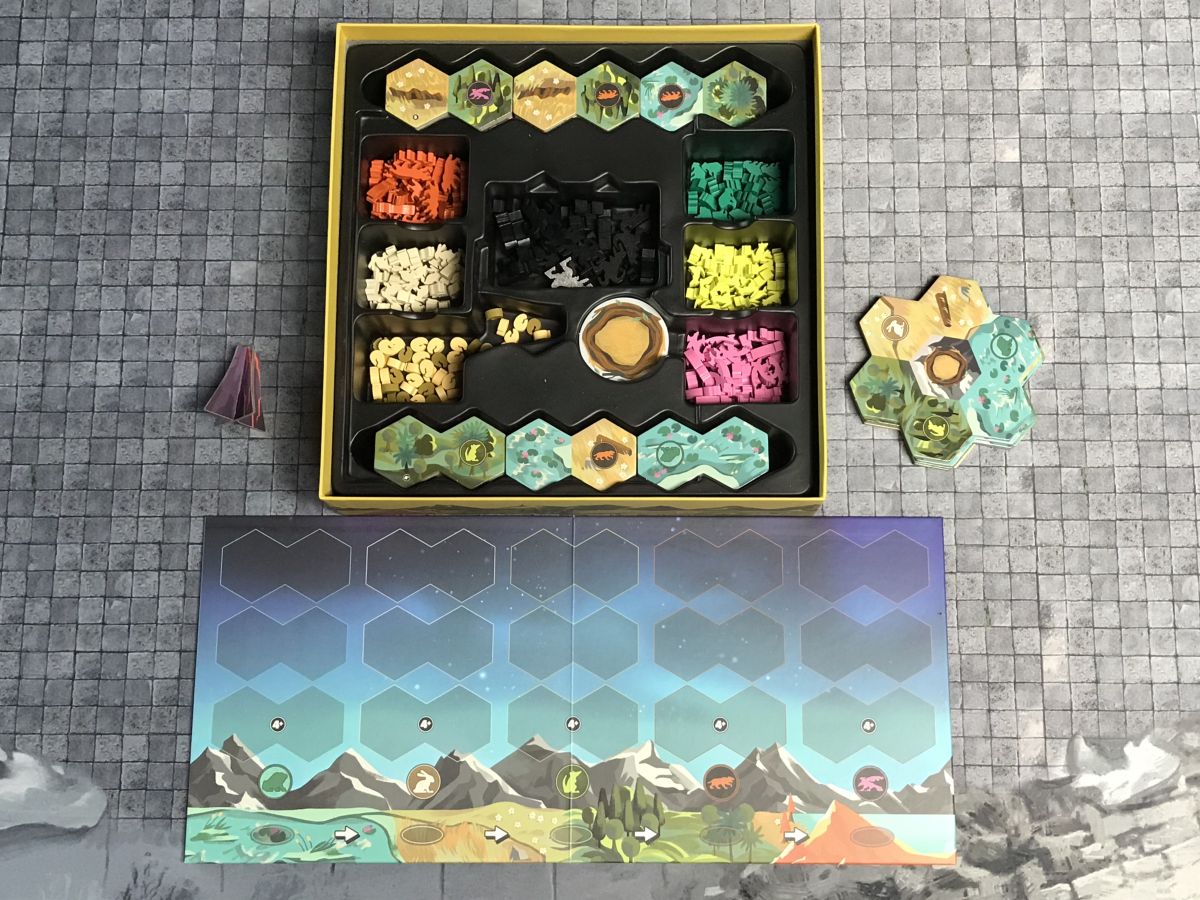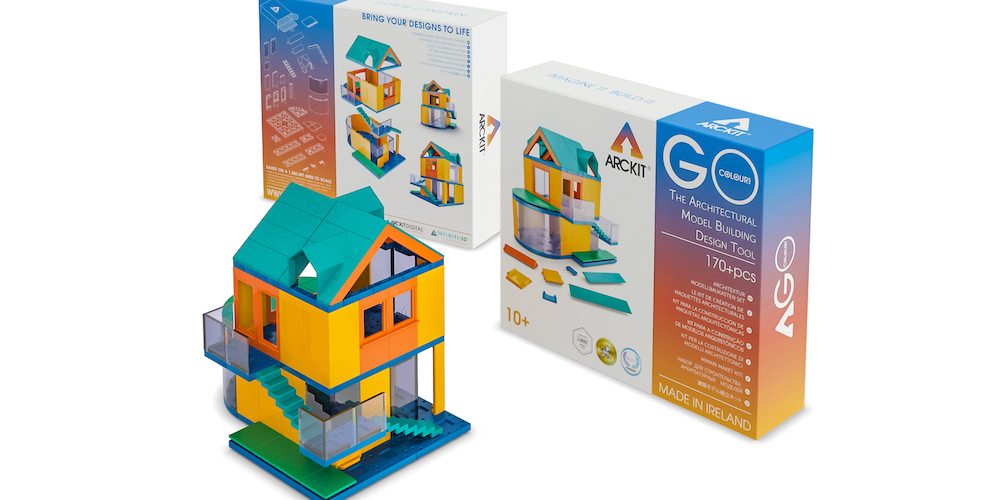Populate your ecosystem with enough animals to allow your dinosaurs to reign supreme at the top of the food chain.
What Is Gods Love Dinosaurs?
Gods Love Dinosaurs is a tile-drafting and placement game for 2-5 players, ages 10+. It plays in 30-45 minutes. It’s designed by Spiel des Jahres-nominated designer Kasper Lapp, with art by Stevo Torres. It retails for $39.99 and is currently available to purchase directly from publisher Pandasaurus Games, as well as from other stores such as Amazon.

Gods Love Dinosaurs Components
This is what comes in the box:
- Animal Board
- 5 Starting Tiles
- 5 Nest Tiles
- 84 Ecosystem Tiles
- 1 Volcano Standee
- 20 Dinosaurs
- 35 Rats
- 25 Frogs
- 30 Rabbits
- 25 Tigers
- 25 Eagles
- 30 Regular Eggs
- 15 Golden Eggs
As you can probably tell from the above photo, the game comes with a very nice insert to hold all the components. While it doesn’t do anything to enhance gameplay, well-designed inserts do make one’s life easier when setting up and breaking down the game. I’m always appreciative when attention is paid to the storage of the game as well as the components themselves.
Speaking of said components, everything is of very high quality. Stevo Torres’ simple but bold graphical style nicely illustrates the boards and tiles, with well-differentiated terrain (important as the type of terrain will determine where different animals can expand during the game).

The art reminds me a bit of Kwanchai Moriya’s work in Cryptid, another game that features multiple different types of terrain.
Besides the tiles, the bulk of the components are taken up by the various wooden meeples for the many animals you will be playing with during the game, from lowly rats up to the mighty dinosaurs. There are also wooden egg tokens, which function both to hatch more dinosaurs and to represent points in the endgame scoring. These meeples are all very identifiable by their shapes, and it’s quite charming having all of these different animals to populate your tiles.

How to Play Gods Love Dinosaurs
You can download a copy of the rulebook here.
The Goal
Lay as many dinosaur eggs as you can by strategically expanding your ecosystem and food chain.

Setup
Separate out the Ecosystem Tiles first by player count (as indicated on the tiles) and then into four stacks according to the letters on the backs of the tiles. Shuffle each stack and place them in the play area above the Animal Board.
Create piles of eggs and dinosaurs, and place them next to the Animal Board. Place piles of the different animals underneath their matching animal column on the Animal Board.
Reveal Ecosystem Tiles from the “A” stack and place them face up in each empty slot on the Animal Board. Leave the third row empty if you are only playing with 2-3 players. Place 1 dinosaur at the bottom of the frog column on the Animal Board.

Each player takes a Starting Tile and a Nest Tile. Place a frog, rabbit, and rat on the matching icons on the Starting Tile, and 1 dinosaur on the mountain hex in the center of the tile. Place 3 regular eggs on the Nest Tile.
The player with the sharpest teeth goes first.
Gameplay
On your turn, you will always choose 1 Ecosystem Tile from the Animal Board, and add it to your Starting Tile, thus growing your ecosystem. You can choose any face-up tile, and place it in any orientation, as long as it touches at least one other hex. If the tile has an animal icon on it, you will take a matching animal piece from the supply and place it on the icon.

If you have taken the last tile in an animal column, that animal activates using the following steps:
- As the active player, you take the Volcano Token.
- All players simultaneously activate all animals of the type from the newly empty column.
If it is a prey animal (rat, frog, or rabbit), it will expand into adjacent hexes if they are of the favored terrain type for that animal: Lake for frogs, Forest for rats, and Fields for rabbits. Take an animal piece from the supply and place it onto the adjacent hex. Only one animal can exist on each hex. Any prey can expand into a wild hex.

If it is a predator animal (tigers, eagles), they move according to the animal. Tigers can move up to 2 hexes in any direction. Eagles can move up to 3 hexes, but it must be in a straight line. The types of terrain they move through don’t matter.
Predators must end their hunt on a hex with prey, otherwise, they starve and are removed from your ecosystem. The prey animal they end their move on is removed. Also, if the predator has passed over any other prey before stopping, that prey is also removed, but replaced by another predator animal of the same type, representing the offspring of that predator.
After animal activation, if the dinosaur marker is also in the same column on the Animal Board, then there is a Dinosaur Activation. The following steps then occur for all players simultaneously:
- Dinosaurs Hatch. If your mountain hex on the center of the Player Tile is open, you can discard 1 of the eggs from your nest to hatch a new dinosaur. Take a dinosaur from the supply and place it on your central mountain hex.
- Dinosaurs hunt. You may choose to move any of your dinosaurs. Each dinosaur moves up to 5 hexes in any direction but must end their turn on an empty mountain hex (which can be the one they started on). Every animal the dinosaur moves through is eaten. For each predator eaten, add 1 egg to your nest. If a dinosaur doesn’t eat anything, it starves and is removed from your ecosystem. Note: At any time you can discard 5 eggs from your nest and replace it with 1 golden egg, which counts as 5 eggs.
- Move Dinosaur Marker. Move the dinosaur on the Player Board to the next animal column.
- Refill Animal Columns. Starting from the leftmost column, refill each animal column that is empty, starting with the “A” stack, and then, once that stack is empty, moving on to “B”, then “C,” and finally the “D” column.
Game End
Whenever all four stacks of tiles are empty, the game ends immediately. Players add up their points, getting 1 point for each regular egg in their nest, 5 points for each golden egg in their nest, and 1 point for each dinosaur in their ecosystem.
Why You Should Play Gods Love Dinosaurs
Let’s get this out of the way first thing: if you’re looking for a game with a lot of player interactivity, this is not it. You’ll be spending most of the game trying to solve your own personal puzzle: how best can I draft and place tiles, so that I can grow the animals in my ecosystem, and thereby feed my dinosaurs, allowing them to breed and give me victory points. Yes, you can monitor your opponent’s moves and intentionally deny them a tile that would be beneficial to them, but otherwise, you’ll be focused on your own ecosystem, not theirs.
The mechanics of expanding your prey animals, having predators eat them to expand the predator population, and then dinosaurs eating everything, leads to a very interesting push-pull dynamic. You will often fill your ecosystem with animals, and then when a predator and/or dinosaur activates, you will nearly empty out the ecosystem. The only way to refill the system with animals is by placing new tiles with animal icons, so you’ll be expanding from the outside in. I’ve never played a game before that has this constant expansion and contraction. And of utmost importance during all of this is that you plan paths for your dinosaurs. When a dinosaur activates, it must both be able to eat something and finish its move on a mountain hex, otherwise, it starves and is removed from your ecosystem… and, in essence, you’ve also just lost a point for the end of the game.

My one complaint about Gods Love Dinosaurs is a minor one. I wish that Pandasaurus had included some player aid cards that remind players of prey animals’ favored terrains, how predators move, and how dinosaurs move. While you will likely memorize these fairly quickly, it would be nice to have this in a card for all players, or at the very least, printed on the back of the rulebook. But this is also not a complex game rules-wise, so as I said, a minor complaint.
Gods Love Dinosaurs is an abstract puzzle game with a nicely realized theme. The interaction between predators and prey creates an interesting dynamic, and you’ll be trying your best to grow an ecosystem that, as in the real world, will best sustain life. Much like in real life, there’s a bit of chaos thrown into the mix as well: more often than not, animals and dinosaurs will be activated by other players. As you won’t always have control over when that happens, you may end up in less than optimal situations, even seeing some of your animals starve because you don’t have a pathway to feeding them. But this very uncertainty leads to a bit of excitement in what is otherwise a somewhat relaxed low to mid-weight game.
Click here to see all our tabletop game reviews.
![]() To subscribe to GeekDad’s tabletop gaming coverage, please copy this link and add it to your RSS reader.
To subscribe to GeekDad’s tabletop gaming coverage, please copy this link and add it to your RSS reader.
Disclosure: GeekDad received a copy of this game for review purposes.





